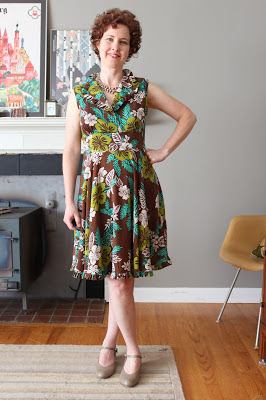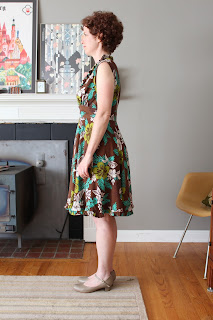 |
| My mother recently gave me this hat. Sadly, I doubt I will have too many occasions to wear the dress and the hat together. That's what blogs are for, I guess--showing off one's hats! |
Oh, I did wrestle with this one. Though I'm dissatisfied with it on several points (and foolishly inclined to make the pattern up again just to prove I can overcome the challenges), at least it is finished and wearable.
The fabric choice, a thin cotton lawn from Maggy London via FabricMart, was my first mistake. Originally purchased with the idea of using it for a blouse, I knew that this limp piece of goods lacked drape and substance. But I had two whole yards of it and I liked the dots, so I fooled myself into thinking it would be fine as a dress. I considered adding a lining, but decided to wear it with a full slip instead. That turned out to be a good choice, because I would never have persisted in trying to alter it if there had been a lining to deal with. Underlining, however, might have made a positive difference.
I may have cut one of the front skirt panels slightly off-grain, because it won't hang well no matter what I do. "Hang" is a bit of a misnomer, really, since the fabric is so light. "Float" is probably more accurate. It floats crookedly.
The major difficulties lay in the fit of the bodice. I mistakenly thought that cutting a size 6 in the upper chest and back would be narrow enough to avoid gaping. Not so. It was necessary to remove the center back zipper (and facing) to take out 1/2" of width per side, curving to rejoin the seamline five or six inches further down the back.
 |
| "Styled", if we can call it that, with red beads in place of the pearls |
After applying the sleeve, bias tape was used to finish the entire circumference of the armhole. Unfortunately the whole business feels a little uncomfortable. I can move my arms just fine, but it rubs a bit under there. This is often a problem for me: providing enough room for comfort while covering the bra and avoiding gaping.
In for a penny, in for a pound, I finished it up with a self-made belt, using the last of my belting and buckles to cover in the process. Must restock!
Simplicity 1882, which I've made before, may be a better choice for a comfortable summer dress with a vintage flavor. The curving v-neck and collar are flattering without presenting such difficulties of fit.
Do you ever find yourself struggling to "let go" of an idea, even when you know it's probably a waste of time and material? This dress threw down the gauntlet, and it's hard to just let it lie there and move on to the next thing, though I really think that's what I ought to do.


















































